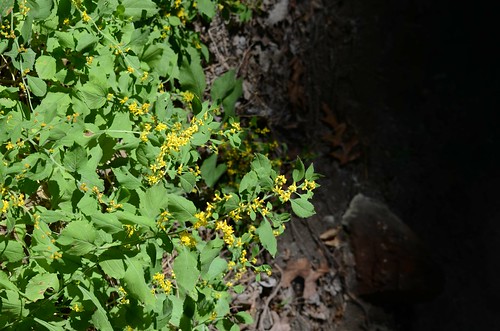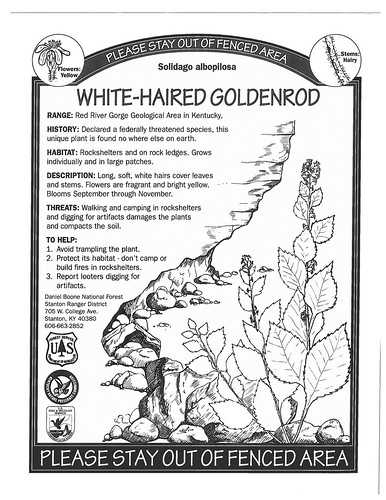
This post is part of the Science Tuesday feature series on the USDA blog. Check back each week as we showcase stories and news from USDA’s rich science and research portfolio.
A hike through Kentucky’s Red River Gorge is a trip that outdoor enthusiasts never forget. The adventure begins amid rugged terrain with towering sandstone cliffs that contour steep, forested slopes. Visitors discover hundreds of natural stone arches and other unique rock features that create some of the most splendid geological formations east of the Rocky Mountains. Within the beauty and solitude of the gorge resides a rare plant found nowhere else in the world.
The white-haired goldenrod occurs predominantly in the Daniel Boone National Forest, typically found growing along the base of cliffs or on ledges. In areas where the ground is undisturbed, this plant thrives in moist, sandy soil underneath rock shelters. During the fall, the plant blooms with bright yellow flowers along its upper stem. Alternating white-haired leaves line the stem from its base.
In 1988, the white-haired goldenrod was listed as threatened under the Endangered Species Act. The species stood at slightly more than 90 colonies, with many of the plants in each colony rapidly declining. Frequent ground disturbance from dispersed camping, hiking, rock climbing and rappelling along the base of cliffs accelerated the plant’s decline.
With concern growing for the future of the species, the U.S. Forest Service and partnering agencies began efforts to protect and restore the goldenrod. They realized that a simple, grassroots approach was necessary for immediate action to occur on the ground. To divert foot travel and prevent trampling, the plants needed protective barriers. The partners put their heads together and brainstormed on available easy-to-install fencing. What’s the quickest and least expensive way to create a fence in this neck of the woods? Chicken wire. Yes, chicken wire…accompanied by some well-designed interpretive signs to explain its purpose.

An amazing thing began to happen. Not only did recreational visitors respect these fenced areas, they began self-policing these sites and spreading the word about white-haired goldenrod recovery efforts. The plant gradually began to spread and return to areas where it once grew—its path to recovery paved with the help of national forest visitors dedicated to protecting nature.
The wire fences and interpretive signs remain in place today, and backcountry rangers continue sharing with visitors the story of white-haired goldenrod. The Forest Service continues to monitor plant recovery efforts with multiple partners, including the U.S. Fish and Wildlife Service, Kentucky State Nature Preserves Commission and Red River Gorge Climbers Coalition.
In 2015, the Forest Service announced the proposed delisting of white-haired goldenrod from the federal threatened and endangered species list.
Because of the efforts of so many, it looks like a golden future for the white-haired goldenrod.




